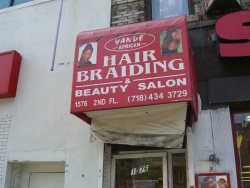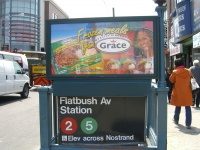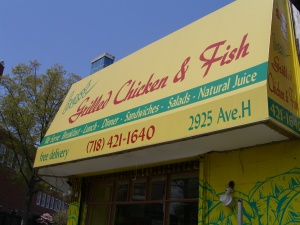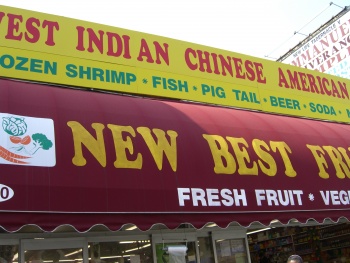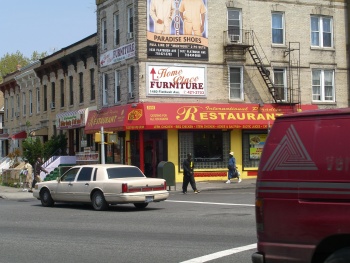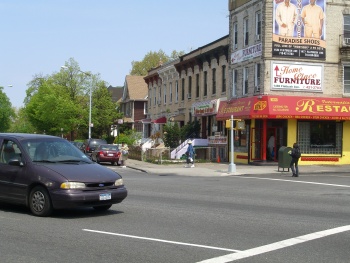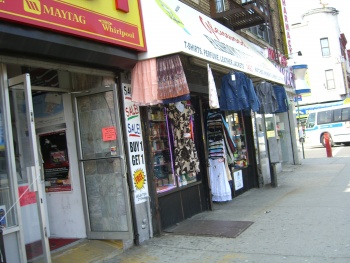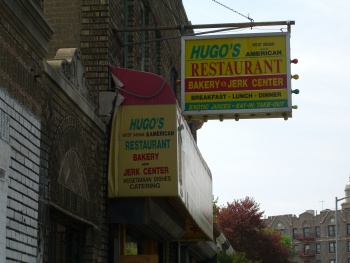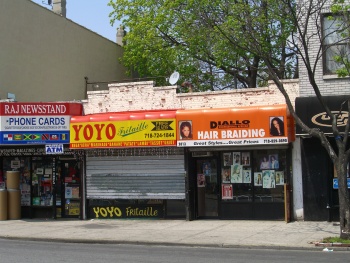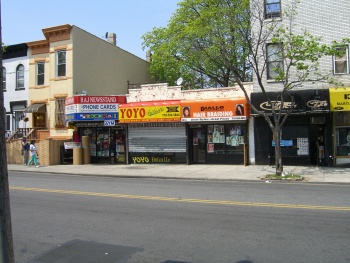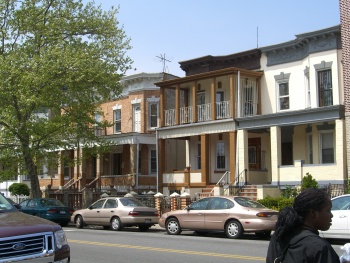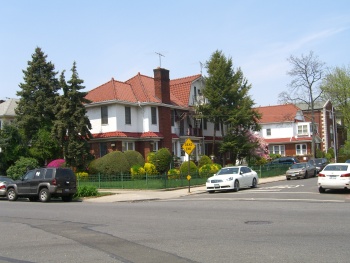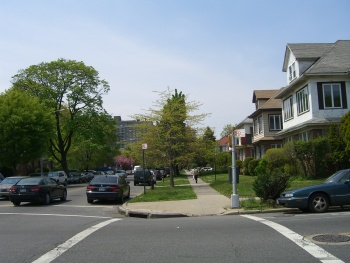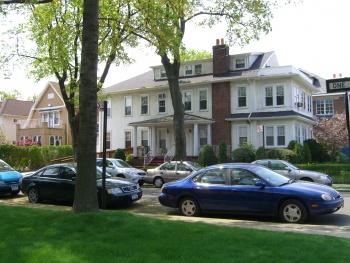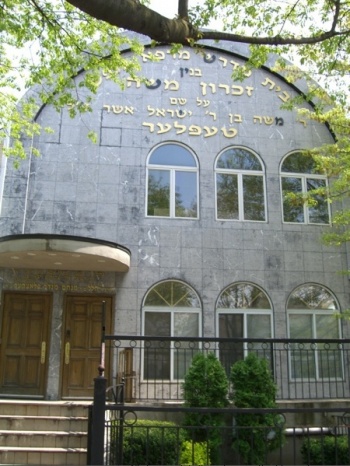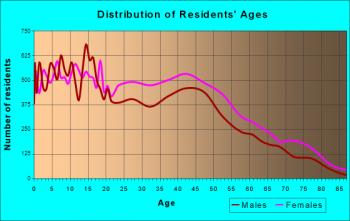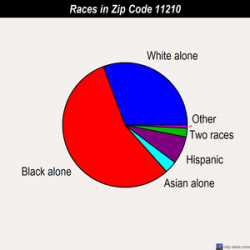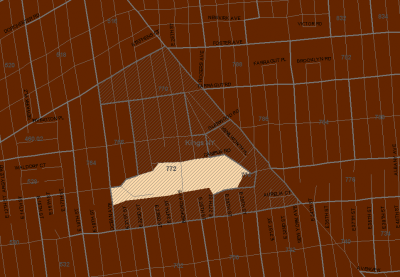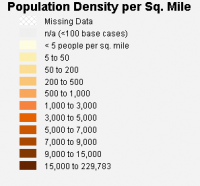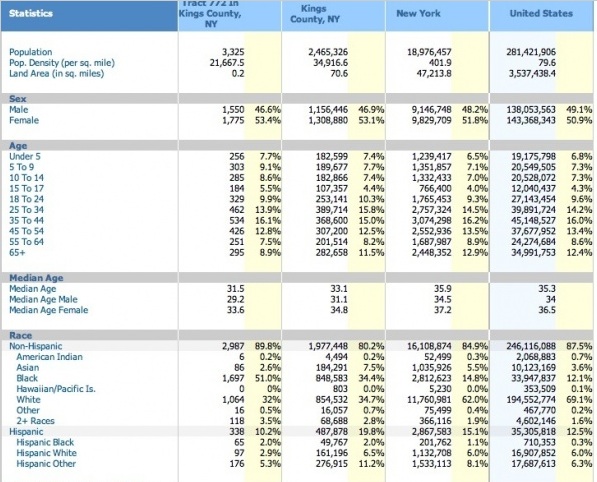East and West of Brooklyn CollegeFrom The Peopling of New York City
IntroductionWhile it is only a subsection of a city, the borough of Brooklyn could easily be a city in its own right. Walking a block away can completely change the demographics, culture, and facilities that one can see. Brooklyn College itself, just a small part of the Midwood neighborhood, can be considered a divide between two distinctly different populations inhabiting the same area. Along Flatbush avenue, there is a very strong and vibrant West Indian community. Restaurants, businesses, and simply the people walking on the street reflect how ethnically specific the community is. On the other side, as you walk towards Kings Highway, it is mainly a housing community owned by Orthodox Jews. The fact that much of the houses are owned by Jews in a tightly knit neighborhood reflects the ethnic specificity of this area also. In between, Brooklyn College is composed of a myriad of ethnicities and races, both Jewish, West Indian, and much more reflecting a prime facet of an ideal community. What is an Ideal Community?Zujaja's Ideal CommunityTo borrow a phrase from Benjamin Franklin, a community should fit its inhabitants like a glove. Conversely, for the community to thrive, each inhabitant must contribute therein. One essential component of an ideal community is that it must be able to incorporate residents from any background. It does not have to necessarily already have a diverse population, but it must be conducive to the creation of one by having, at the very least, the absence of outward racism or racial quotas. This way, a community is available to anyone and anyone can be productive within its system. In places that are not as large as metropolises like New York City, a city usually provides as much space and resources as a borough of NYC. Once the community becomes open to diversity, it must develop a variety of commercial and financial enterprises that can accommodate people of varying skilled or unskilled professions, allowing more groups of (im)migrants to find a job and establish a livelihood there. A city’s continuing success and future then becomes contingent on a good public educational system. Public school education is available to all, and it usually brings its students into contact with people/ideas/experiences from a larger demographic than in private school systems. A healthcare system is mandatory for obvious reasons. Furthermore, a city should accord its resources in such a manner so as to provide the basic necessities of life to all its citizens, i.e. shelter, food, and medicine, as best as it can. Ankuri's Ideal CommunityI believe that an ideal community has many different aspects, including a diverse population, access to information and goods, and the availability of education as well as religious services. The existence of heterogeneity of race in a community’s population is important because it provides exposure to a variety of beliefs and ideas. This is essential for the people of this community because if they leave their neighborhood for another, they are more able to coexist with other peoples. Additionally, the existence of a variety of thought is positive when dealing with business, economy, and other affairs as it supplies new ideas. However when a diversity of races live within a neighborhood, antagonism may arise, as this is an ideal community, the peoples of this neighborhood have all learned to peacefully coexist and even intermingle. In addition to ethnic diversity, an ideal community must have access to information and goods, meaning the existence of newspapers and stores. There needs to be a variety of newspapers and stores available for the people of this diverse community so all are able to find what they need. A library also needs to be located within the community or nearby, so people can obtain valuable information and resources if necessary. The community must also have a school that the children of the neighborhood may attend. Places of worship for the different religions followed in the community must also be present, so the people would be able to practice their beliefs freely. The people of the community must respect each other’s beliefs, creating no ethnic or racial tension, so the community may be successful. East and West of Brooklyn College creates neighborhoods that amalgamate many of the different aspects of an ideal community. including a diverse population encompassing both Orthodox Jewish and West Indian residents, the availability of religious services, and tolerance of different cultures, as both the Orthodox Jewish community and the West Indian community, no matter how disparate their beliefs, respect each other's cultures. Sara's Ideal CommunityPeace, diversity and tolerance are perhaps few of the most essential characteristics of an ideal community. Such a community would foster solidarity yet heartily welcome newcomers. Its members would be of diverse backgrounds and would be able to freely practice their various cultures and traditions. Thus, those of numerous backgrounds and religions would live peacefully and perhaps even unified. They would embrace their personal ideologies while being tolerant of those of others. The neighborhood would also be rather dynamic, with constantly changing people members and traditions while maintaining a stable total population. This community would not only guarantee equal opportunities for participation in politics but would also encourage voting, attending local meetings and other types of participation. It would also provide the best education possible by having adequately funded schools and libraries. Education would be encouraged, if not stressed, through these and other institutions. This community would also be safe by sufficiently enforcing laws and regulations and having responsive police and emergency services. Roads, trains, and other public facilities would routinely be inspected and maintained. There would also be various well-sustained parks and playgrounds. This community would be able to help those in need through support programs by having community centers, at minimal or no cost. Also important would be providing support for the underprivileged though volunteer programs, aid and the like. Equal opportunities would be provided to all and a universal—or that the least, a significantly developed—healthcare system would allow everyone to obtain the medical attention they need. Lastly, this small, quiet suburban community would be open to—or at least tolerant of—change. Nickeitta's Ideal CommunityI reside on Vermont Street, a block in East New York, Brooklyn. An industrial neighborhood, many of the local businesses in East New York are auto shops and car dealerships. Therefore, my neighborhood is not quite residential. The various blocks are mucky, narrow, loud blocks tarnished with car grease and other aspects of the auto businesses around the vicinity. My block in particular is aligned by apartment buildings on both sides. Perpendicular to Vermont Street the J train line run directly above along Fulton Street. However, the most appalling feature of my block is its lack of diversity. My family is one of two African American families that reside on Vermont Street, a predominantly Hispanic block. Using the aspects of my block as a guide I have created a perception of what an ideal community should look like. My ideal community is a quiet and pleasant little suburban community. The blocks of this community are spotless and very wide. Brownstone family homes with ample yard space and many trees align the blocks of this community. The extremely green, neatly mowed lawns are well maintained and the buildings are not flawed by graffiti. Also the residents of this community are not disturbed by the unbearable sounds of trains traveling overhead. The various train lines in this community are underground lines. Residents of various races and nationalities occupy my ideal, diversified community in which the rate of violence is low. And last but certainly not least my ideal community is a unified community in which all the residents work together to help maintain the standards of such a community. East and West of Brooklyn College as an Ideal Community: Two Worlds, CoexistingWest Indian CommunityAccording to the 2000 census 17,962 (31.67%) of the residents living in Flatbush, primarily Flatbush Avenue reported themselves as West Indian. Mostly Haitian, Jamaican, Trinidadian or Tobagonian and Guyanese these individuals make up the majority of the 11210 zip-code residents. Thus, the neighborhood is referred to as West Indian Flatbush. New York City is known for massive waves of immigration to the city. Often referred to as the “Melting Pot” it is believed that these immigrants to New York City have assimilated into one culture. However, West Indian immigrants of Flatbush Avenue did not truly melt into the pot. West Indian immigrants brought their cultural dance, music and food, with them to the United States and have retained distinguished characteristics of their culture which ironically U.S citizens adapted. Today West Indian food and music are two primary cultural aspects that have become major parts in American culture. For example, many West Indians established their own shops and businesses that provide Caribbean products and services to their consumers. Much of Flatbush Avenue is lined with West Indian stores, from grocery stores to hair braiding salons. The vibrant West Indian culture is even reflected on subway station billboards, which have ads for West Indian cuisine. Churches can be found nearby, reflecting the Christian faith of many West Indians. Walking by some stores that may not reflect West Indian culture from the outside, from the inside, West Indian music can be heard being played!West Indian Culture: "Knowing the history of the Caribbean region goes a long way toward understanding its people. Each island has a unique cultural identity shaped by the European colonialists, the African heritage of slaves, and the enduring legacies of the native Indian tribes. This rich history and its lasting influence is set against a backdrop of crystal clear waters and perpetual sunshine.The Caribbean lifestyle is undoubtedly a product of its tropical setting. The music, architecture, attitudes and customs have all, in some way, been shaped by the physical landscape and climate. The cultures of the Caribbean countries are a blend of colonial mainstays and pervasive influences by major ethnic groups of the region such as East Indians and Africans" [excerpt from Into the Mix, an article found on caribbean-guide.info]. African Heritage & Its Influence on Caribbean Culture: "Old African culture and customs influence much of the religious worship, artistic expression, rhythmic dancing, singing and even ways of thinking in the Caribbean. Spiritual practices such as Junkanoo in the Bahamas, Santeria in Cuba, Voodun in Haiti, and Rastafari in Jamaica are African-influenced movements that have Caribbean origin but a worldwide following. Reggae music and jerk cooking are also Africa-inspired gifts to the world from the Caribbean. In the Eastern Caribbean Soca Tradition, for example, the limbo dance ritual has its roots on the slave ships that came to the colonies on the horrific 'Middle Passage'" [excerpt from Into the Mix, an article found on caribbean-guide.info]. Music: "Music has been central to Caribbean culture since the days of slavery, when it was a mode of mental survival and a form of recreation. Today there is a ubiquitous Caribbean soundtrack; it plays on city streets, in natives' homes and at special festivals - at Carnival people tirelessly dance for days. It is characterized by a natural, easy rhythm and multiple ethnic influences, particularly the African drum beat" [excerpt from Into the Mix, an article found on caribbean-guide.info]. Some genres of music in the Caribbean that has become popular outside of the Caribbean are Reggae, Calypso, Soca and Chutney. Food: Similar to the music of the Caribbean, Caribbean recipes combine African, Amerindian, French, East Indian, and Spanish styles of cooking. Popular recipes of the Caribbean are rice & peas,jerk chicken,and curried goat. Another favorite recipe of the Caribbean is "Cook-up", or Pelau. This dish combines meats like chicken, beef, pig tail, saltfish, and vegetables with rice and pigeon peas. Seafood is also a common delicacy in the Caribbean due in part to their geographic location.Festivales: The islands of the Caribbean are known for their carnival celebrations which immigrants to the United States has bought with them. Some noteworthy carnivals held in the United States are those held in Boston, Baltimore and our city's West Indian Day Parade held on Labor Day on Eastern Parkway. During Labor Day weekend numerous events are held in New York City leading up to the grand parade held on the first Monday in September. One event worth mentioning is J'Ouvert held on Flatbush. J'Ouvert (pronounced Joo-VAY and often spelt as Jouvert ) means daybreak and is a grass-roots revival of an old Trinidadian custom. It is a mini pre-labor day parade that features steel bands and mud mas. This event is held early Monday Labor Day morning about 3am and end about 9am. The Steel bands prepare music just for this parade and compete for Best Playing Band on the Road and also for Best Costumed Band.
Orthodox Jewish CommunityOn the other side of Brooklyn College, the Bedford Avenue side, exists a strong Orthodox Jewish neighborhood. A wave of Orthodox Jews moved into the area in the 1980s and 1990s, attracted largely by the residential atmosphere. More recently, the area has a large Sephardic population as well.The area is mostly residential, reflecting the family-oriented lifestyle of the culture. Synagogues, Hebrew Schools, and other particularly Jewish buildings can be found. In observance of the Jewish Sabbath, many of the stores along Avenues H-O, Aveune J and Avenue M close early on Fridays until Saturday evening. As can be seen, this neighborhood adjacent to Brooklyn College is very residential. It can almost be mistaken for a suburban area, as many trees, cars, and houses can be seen. However, this area is only a few minutes away from bustling Flatbush Avenue! Neighborhood Statistics: Midwood, BrooklynThe following are statistics of zip code 11210/census track 772 in Brooklyn, New York. The neighborhood population was 62,308 in 2000.
Age Distribution in Zip Code 11210:
Races in Zip Code 11210: Black/African American: 36,146 White: 20,516 Asian: 1,969 Two or More Races: 1,865 American Indian: 129 Native Hawaiian and Pacific Islander: 24 Some other race: 1,659 Foreign born population: 25,565 (41.0%) (56.4% of them are naturalized citizens) This zip code: 41.0% Whole state: 20.4%
Most Common Places of Birth for Foreign Born Residents:
Year of Entry for Foreign Born Residents:
Looking at the census tract information, I am able to learn that my neighborhood (tract 772 in Brooklyn, part of Midwood) has more young people than New York as a whole, as well as the United States. The median age of the population in my neighborhood is about four years less than that of New York and the United States. It is two years less than the median age for Brooklyn residents. Additionally, my neighborhood and Brooklyn in general, has a higher female population as compared to New York and the United States. A little over half of the residents in my neighborhood are classified as Black, which is a much higher percentage than both Brooklyn and the rest of New York. The races that make up the majority of my neighborhood's population are Black, White, and Hispanic. The Asian population is just 2.6%. The native born population is a little higher than the foreign born population. The native born population, to which I belong, is six percent less than the percentage of native born residents throughout Brooklyn. Hence, my neighborhood has more immigrants than Brooklyn taken as a whole. The median household income of my neighborhood is higher than that of the average in Brooklyn, New York, and the United States. The population density of my neighborhood is much less than that of the population density of Brooklyn. Group Members: |
